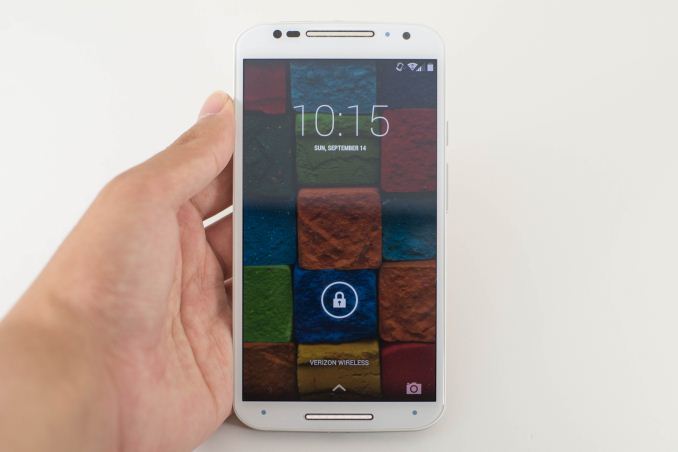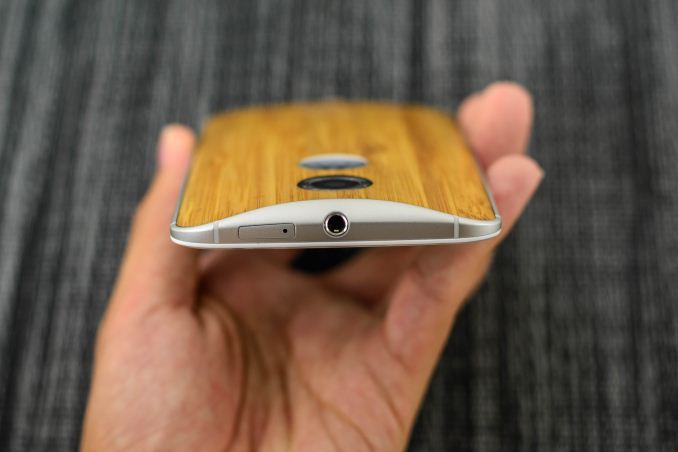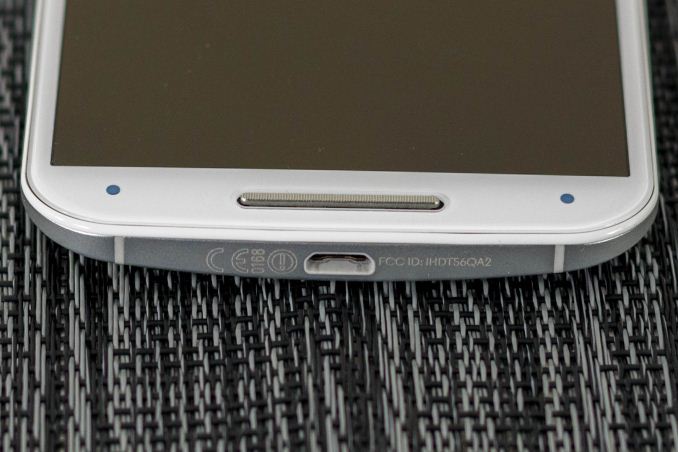The New Motorola Moto X (2nd Gen) Review
by Joshua Ho on September 17, 2014 9:00 AM EST- Posted in
- Smartphones
- Motorola
- Android
- Mobile

Introduction
While I talked about Motorola’s issues in the launch article for the new Moto X, it’s well worth repeating. Motorola has been through a lot these past few years. Once the iconic symbol of Android with their Droid smartphones, Motorola had lost its way. It wasn’t unusual to see one phone launch after the other, with no real regard for strategy, and no real cohesive message to tie all of their devices together. If anything, there was a point where Motorola had become an ODM for network operators in the US, with no real international presence. After Google acquired it in 2012, we saw the launch of the Moto X in 2013. The amount of hype that I saw online before the announcement of the Moto X was unlike anything I’ve ever seen.
Unfortunately, the device that launched didn’t quite fit with the hype. The Snapdragon S4 Pro chipset was decidedly mid-range by the time it launched. The display was good for the time, but AMOLED wasn’t quite the imminent LCD replacement that it is today. The camera was also rather unfortunate at launch. For better or worse, the Moto X was a phone with the right size and shape, but a lot of hardware choices that aged poorly. This leads us to the new Moto X. On the surface, this phone corrects a lot of issues that were present in the original Moto X. The new Moto X brings an SoC that is up to par with its competition, a new camera with a Sony sensor, and an improved AMOLED panel. Of course, I’m not going to spend too much time covering the basic specifications when a table will suffice.
| Motorola Moto X (Gen 1) | Motorola Moto X (Gen 2) | |
| SoC | 1.7 GHz Dual Core Snapdragon S4 Pro | 2.5 GHz Quad Core Snapdragon 801 |
| RAM/NAND | 2 GB, 16/32/64GB NAND | 2GB, 16/32GB NAND |
| Display | 4.7” 720p Super AMOLED | 5.2” 1080p Super AMOLED |
| Network | 2G / 3G / 4G LTE (Qualcomm MDM9x15 IP block UE Category 3 LTE) | 2G / 3G / 4G LTE (Qualcomm MDM9x25 IP block UE Category 4 LTE) |
| Dimensions | 129 x 65.3 x 5.7-10.4mm, 139 grams | 140.8 x 72.4 x 3.8-9.9 mm, 144 grams |
| Camera | 10MP Rear Facing, 1/2.6" CMOS size (OV10820), 2.1MP FFC | 13MP Rear Facing, 1/3.06" CMOS size (Sony IMX135), 2.1MP FFC |
| Battery | 2200 mAh, 3.8V, 8.36 Whr | 2300 mAh, 3.8V, 8.74 Whr |
| OS | Android 4.4.4 | Android 4.4.4 |
| Connectivity | 802.11a/b/g/n/ac + BT 4.0, USB2.0, GPS/GNSS, MHL, DLNA, NFC | 802.11a/b/g/n/ac + BT 4.1, USB2.0, GPS/GNSS, MHL, DLNA, NFC |
| SIM Size | NanoSIM | NanoSIM |
As with most reviews, physical impressions are always a good place to start. In terms of look and feel, the new Moto X starts off incredibly well. The metal frame is something that Motorola is especially proud of, as they've managed to enable an external antenna design without causing some of the infamous deathgrip issues. At any rate, it really feels great in the hand, especially because of the varying thickness. The metal frame can be as thin as 3.3mm in the corners, which really feels razor thin. Fortunately, the center is much thicker to provide for better grip. As a result, the phone is secure in the hand and I never really felt like I would drop it. Overall, I really think the feel of the phone is great. While the size is approaching an uncomfortable level, it manages to stay just short of it because the phone is so thin.
However, I’d like to cut this short as I’ve already given most of my initial impressions in the launch piece. While I haven’t been able to get around to writing my experience with Motorola’s tour, Motorola and their PR team have done an incredible job of introducing the product and allowing for plenty of time to get first impressions, photos, and ask all kinds of questions.
Cellular Architecture
Instead, given the amount of information disclosed by Motorola, I wanted to start this review with a discussion about cellular architecture, as it’s one of the few areas where we still seem to be working with black boxes. For those that are unfamiliar with the basics of how current RF architecture is set up, there are a few major components to talk about. We have antennas, antenna switches and duplexers, band filters, power amplifiers, a transceiver (which is made of multiple parts but that’s for another day), and the modem.
So let’s talk about what’s in the new Moto X. While antennas are still an area I’ve been working on learning more about, we can talk about band support on the Moto X. I’ve attached a table below with a full list of supported bands.
| Motorola Moto X (2014) | ||||||||
| FCC ID | Operator/Region Target | CDMA Bands | GSM | WCDMA | LTE | CA | ||
| IHDT56QA1 (XT1095/XT1097) | AT&T/T-Mobile USA | - | 850, 900, 1800, 1900 | 850, 900, AWS, 1900, 2100 | 2, 3, 4, 5, 7, 17, 29 | - | ||
| IHDT56QA2 (XT1096) | Verizon | 800, 1900 | 850, 900, 1800, 1900 | 850, 900, 1900, 2100 | 2, 3, 4, 7, 13 | - | ||
| IHDT56QA3 (XT1092) | ? | 800, 1900 | 850, 900, 1800, 1900 | 850, 900, AWS, 1900, 2100 | 2, 4, 5, 12, 17, 25, 26, 41 | - | ||
| IHDT56QA4 (XT1093/XT1094) | EU | - | 850, 800, 1800, 1900 | 850, 900, 1800, 1900, 2100 | 1, 3, 7, 8, 20 | - | ||
What might be notable is the lack of carrier aggregation on the new Moto X, which suggests that there is only a WTR1625L transceiver inside, with no WFR1620 companion chip to go with it. This is a rather conventional configuration at this point, and I suspect that phones with support for carrier aggregation will have to wait until WTR3925 which should be in most high end phones in 2015. The modem is also common at this point, as the MDM9x25 IP block in Snapdragon 800/801 has been around since the LG G2 which launched a year ago.
Of course, the real story here is the antenna tuner which I also wrote about in the launch piece. While most of the antenna tuner is hidden from view, there is one aspect that seems to be exposed to the OS. This one aspect is Cypress Semiconductor’s CapSense controller. This sounds strange, but I don’t think there’s any other explanation for why this controller is present. While it’s normally used for capacitive buttons such as in the Samsung Galaxy S/Galaxy Note line, there are no capacitive buttons or sliders present on the phone. In addition, none of the gestures/actions seem to rely upon capacitive sensing. This seems to rely upon the IR sensor system instead, so that doesn’t make sense either. The touchscreen is definitely an Atmel solution. This leaves the antenna tuner. While a bit outlandish, it seems that this controller is capable of detecting capacitance directly in addition to determining whether a finger/hand is on the sensor or not. While I’m sure that it’s necessary for Motorola to measure the standing wave ratio/signal reflection in addition to capacitive sensing on the relevant antenna pieces, this could give Motorola’s antenna tuner an advantage in speed as the capacitive sensors could detect the change in capacitance and pre-emptively change the tuning in the antennas instead of waiting for an increase in signal reflection before attempting to retune the antenna.













179 Comments
View All Comments
Jon Tseng - Wednesday, September 17, 2014 - link
Nice write-up on the semi content.One thing worth mentioning though might be the Moto Maker customisation options (which we're even getting in the UK!). Some of the premium leather/wood options definitely make the phone stand-out from competition (in a classy way, I might add).
semo - Thursday, September 18, 2014 - link
And once you get over oh la la nonsense you will wonder why you can't buy a more powerful aftermarket battery and why 1080p video recording is a chocolate teapot of a feature without an SD slot.It will be too late by then as you would have parted with your cash and voted for this trend to continue with your wallet. These nice things are only there to distract you from the planned obsolescence.
T1beriu - Wednesday, September 17, 2014 - link
I think the contrast graph is missing.JoshHo - Wednesday, September 17, 2014 - link
Infinite contrast would break the graph. :)s44 - Wednesday, September 17, 2014 - link
A small point... is it correct that only the *Sprint* version will have all the bands for full T-Mo operation when their version of 700mhz (Band 12) finally rolls out? I see Band 17 (due to be rolled into 12 at some point) listed on the GSM/Pure, and though perhaps a baseband update could enable 12, I know better than to expect that without an official announcement.Should full-price T-Mo buyers really be getting Sprint's X instead?
gg555 - Wednesday, September 24, 2014 - link
There's a lot of confusion out there about this. Also, given that Motorola tweeted a few days ago that there would be no Moto X for Sprint, it's not clear if model XT1092 actually exists or will ever be released.As far as I can see, only in this AnandTech review and a post at Android Central is there any mention of an XT1092 model. Also, on the Motorola site the XT1095 and XT1097 are not listed has supporting identical bands, as shown here at AnandTech. The XT1095 (Pure Edition) is show dropping a few of the LTE bands--which makes no sense to make a separate model that all it does is disable a couple bands.
Anyway, if the XT1092 does ever come to exist, as you note, it would be the best for T-Mobile because it supports LTE band 12 (700 Mhz)--which is just bizarre, given that the Pure Edition is being currently sold as the model for T-Mobile.
There's a thread in the Motorola forums where a company representative says they are aware of the confusion and looking into what is the deal with the bands on these phones, but no clarification has come yet.
https://forums.motorola.com/posts/d766a5d90a?page=...
djw39 - Wednesday, September 17, 2014 - link
Is there any thought that if the battery testing methodology ignores differences in devices due to the job scheduling setup and cell signal/wifi reception, that it is not giving the full picture? I'm sure the people at Motorola who worked on the antenna tuning are disappointed that you specifically exclude this from your tests.It seems like the LG G2 is a near-identical device with advantages over Moto in battery & camera. LG should just push their new UI skin out to that phone and keep selling it.
Impulses - Wednesday, September 17, 2014 - link
They made a G3 Mini or whatever that's basically a G2 rehash... Probably has a smaller battery tho, I forget.Problem with taking into account a job scheduler, varying signal conditions, etc is that it makes it near impossible to create a repeatable test with consistent results.
They could add ADDITIONAL tests like: battery life with borderline signal strength or battery life with a consistent sync job... But that would add to their already long battery of tests.
Plus where do you draw the parameters for tests like that (same signal strength for all phones or same scenario with varying low signal strength), and how do you keep it consistent (cell towers have varying loads, get upgraded, etc).
I suppose they could use that signal analyzer with the Faraday box Brian had for a while but I dunno if that could simulate a data traffic load.
leoblaze9 - Wednesday, September 17, 2014 - link
No love for the xperia z/z1/z2/z3 cameras at all??I was under the impression that they were among the best of the best cameras to be had in smartphones especially for android phones
adityarjun - Wednesday, September 17, 2014 - link
@Joshua Ho - A request: if possible please do the battery tests again once Android L is out for this phone.